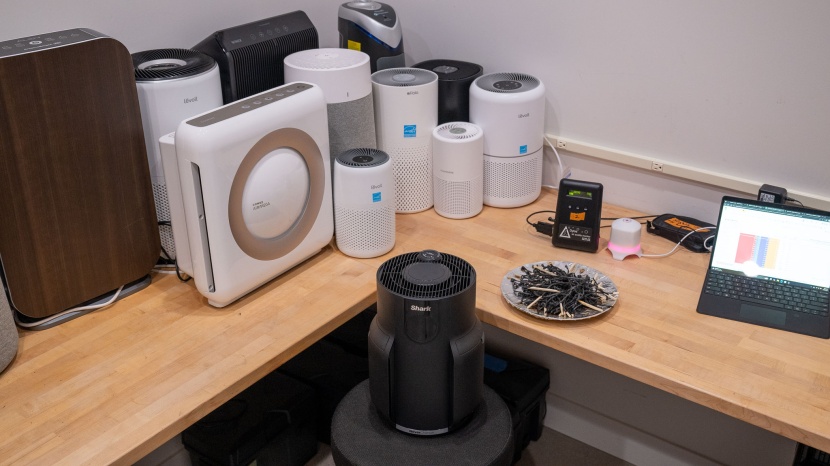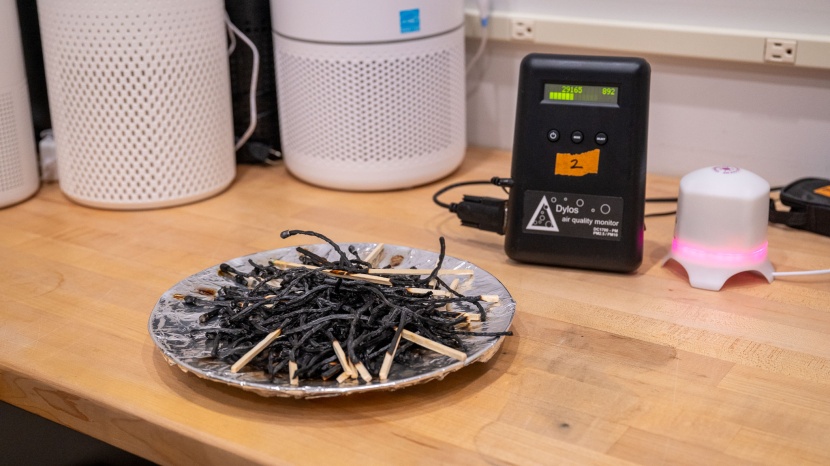The GearLab team knows a thing or two about keeping indoor air free from smoke and pesky allergens. Our lab testing facility is surrounded by national forests, and both pollen and wildfire season can knock the air quality from super to so-so in mere hours. We created a dynamic, hands-on testing rubric to assess which air purifiers are the best for a variety of different needs and budgets, separating out scores into four main metrics.
Air Cleaning Performance
Using a dedicated ~155-square-foot room in our in-house lab facility, our expert testers burned a series of long wooden matches to create an incredibly smoky environment. We then used a portable Dylos air quality monitor to measure when the room's particulate matter reached 10,000 particles per cubic centimeter, which is a fairly standard metric for “poor” air quality. Each air purifier was then turned on its “high” setting and timed while it scrubbed the air for pollutants.
Four key measurements were taken and scored to create an overall Air Cleaning Performance score. Our team measured what percentage of large particles (over 2.5 microns) had been cleared after 10 minutes. We also measured the percentage of small particulates (.5 to 2.5 microns) that had been eliminated in 10 minutes. Afterwards, we timed each air purifier to see how long it took to remove 99% of all large-sized and small-sized particulate matter from the room. The Air Cleaning Performance score is a combination of each of these four measurements.
Noise
It's reasonable to assume that if you're interested in purifying your indoor air, you'd likely want to hang out in that lovely, allergen-free space. Our team assumed that most air purifier users would be spending at lease some time in a room with their trusty device, so we took fan noise into consideration when testing each unit. Using an ordinary measuring tape, we took a portable decibel meter and clocked it from six feet away from each air purifier. This was to represent the average distance you might be sleeping or sitting away from the purifier while it's on. Decibel readings were taken on low, medium, and high fan settings.
Our noise scoring is based on the decibel measurements on high, medium, and low for each unit, measured from a strict six feet away.
Ease of Use
Nobody wants to spend hours setting up their air purifier when they're worried about harmful air quality. As such, we wanted to create objective testing metrics for each unit's ease of use. Each purifier's interface score was rated based on the number of on-unit dials, sensors, and speeds, the ease of utilizing these settings, and the functionality of its paired mobile app, if applicable. The setup score was based off of the difficulty to get each product out of its box and running smoothly, including any issues we had with app pairing. The portability score was based on the weight, shape, and overall bulk of each product and the existence (of lack of) of handles. We used a blend of subjective (number of fan speeds and features) and objective (ease of carrying) for this metric.
The final “Ease of Use” scoring is based on the number of unique features on each purifier's on-unit interface and mobile app, plus the subjective experience of each unit's portability and ease of setup.
Operating Cost
Even the most affordable air purifier can have hidden filter costs or long-term electricity costs pile up if it isn't energy efficient. To accurately measure the annual operating cost of every unit on our list, we utilized a plug-in energy meter and took detailed measurements of the energy draw from each purifier while it whirred away in the background. The power consumption of each air purifier was measured using a Kill A Watt meter on its low, medium, and high fan settings. Electrical costs per year were then calculated based on the U.S. average of $0.17 per kilowatt-hour and the assumption that most people run their air purifier 24/7 and 365 days a year on a mix of high (40% of the time), medium (30%), and low (30%) settings. Filter lifespan was taken directly from the manufacturer's recommended replacement timespan, along with the associated cost to replace the filter exactly this often. These two costs were added to make the total yearly cost for each air purifier. Our team gave each purifier a numerical score based on its annual associated costs and also its general energy efficiency on high, medium, and low. These scores were then combined to create a final score.
Scores are based on each unit's energy efficiency on low, medium, and high speeds, filter costs, and estimated annual operating costs.


